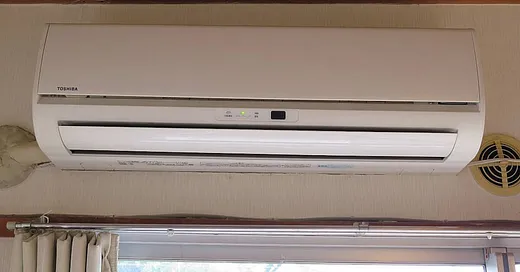Deaths related to extreme heat had fallen. One of the reasons? Increased AC use.
Air conditioning is evil. It’s bad for the environment. Instead it’s better to let thousands die in heat waves.
A 2003 heat wave killed 15,000 people in France. And, in response, the authorities have deployed Chalex, a database of vulnerable people who will get a call offering them cooling advice.The advice consists of taking cold showers and sticking their feet in saucepans of cold water.
Desperate Frenchmen trying to get into any body of water they can have led to a 30% rise in drownings. The dozens of people dead are casualties of the environmentalist hatred of air conditioners.
Only 5% of French households have air conditioning. Even in response to the crisis, the authorities are only deploying temporary air conditioning to kindergartens.
The 2003 heat wave killed 7,000 people in Germany. And, today, only 3% of German households have air conditioning. Germany’s Ministry of the Environment refused to back air conditioning as a response to global warming.
Temperatures in Dusseldorf hit 105 degrees. Officials in Dusseldorf had recently rejected proposals to install air conditioning systems because they’re bad for the environment.
The climate action head at Germany’s Institute for Applied Ecology explained that air conditioning wouldn’t work because there’s not much wind during heat waves, and the country can’t end reliance on coal and run air conditioners at the same time. You can have air conditioners or save the planet.
But not both.
But not everyone in Europe is ready to die for the environment. --->READ MORE HERE
 |
Adopting foreign technologies is scary, but it's what makes a society rich.
Many years ago, I was watching a nature show. It was about some hunter-gatherers on some Pacific island. The film crew went right up and talked to one of the hunter-gatherers about his life — hunting, gathering, finding and killing witches among his fellow tribesmen, and so on. But as they talked, I realized that there must be a giant video camera right in the face of this tribesman. And he wasn’t even reacting to it. What was this strange, unnaturally shaped object, made of strange unknown materials, and potentially possessing magical powers? Didn’t he wonder? And didn’t he ask himself if he could get something like it, and use it for whatever these strange foreigners were using it to do?
I often think about the example of the tribesman and the video camera. It’s a small version of a story that happens again and again, on a far grander scale, determining the fate of entire nations and geopolitical systems of power: absorption of foreign technology. Most of the things you use on a day-to-day basis were not invented in the country in which you live (even if you live in America). They were invented all over the world, and one crucial reason you have access to them is that your society deemed it fitting to allow those technologies into the country.
Adopting foreign technologies sounds like a no-brainer, but there are lots of risks involved. Hierarchies of power and status can be disrupted, creating political chaos. Existing economic relationships can shift, creating unexpected winners and losers. But perhaps most frighteningly, foreign technology can change a country’s traditional culture.
One Pacific island civilization that was determined to absorb foreign technology without letting it change their culture was Japan. When the “black ships” from the West arrived in the 1850s and demonstrated how helpless Japan was in the face of foreign powers, the country’s leadership (after a brief civil war) decided that their only choice was to absorb foreign technologies and institutions. But they wanted to preserve Japan’s traditional culture as well. They thus came up with the concept of “wakon yosai” (和魂洋才), which translates roughly as “Japanese soul, Western technology”. Over the course of the next century and a half, Japan intentionally strove to preserve elements of its unique culture even as it reshaped its society around new gadgets and production processes.
Travel to Japan today, and I guarantee that unless you are staying in a very backwoods rural place, the room where you stay will have an air conditioner. It will almost always be a “mini split”, or wall unit, looking much like the image at the top of this post. It will be quiet, but powerful enough to keep your room cool even in the increasingly hot summers that Japan now suffers due to climate change. This is a technology never available in Japan’s premodern days, and yet it has been near-universally embraced with no apparent degradation to the country’s traditional culture or national pride.
Europe is different. Data sources differ, but nobody puts AC usage in Europe (or the UK) at more than around 20%. This technology, which almost all Japanese people enjoy, is one that most Europeans do without.
You might think Europe is simply too far north to need AC. But latitude is no longer the defense against heat that it used to be, because climate change is stalking the region: --->READ MORE HERE
If you like what you see, please "Like" and/or Follow us on FACEBOOK here, GETTR here, and TWITTER here.


No comments:
Post a Comment